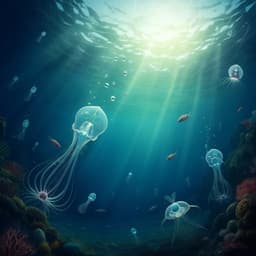
Earth Sciences
Small phytoplankton contribute greatly to CO2-fixation after the diatom bloom in the Southern Ocean
S. Irion, U. Christaki, et al.
Discover the pivotal role of small phytoplankton in CO2 fixation in the Southern Ocean, as revealed by research from Solène Irion, Urania Christaki, Hugo Berthelot, Stéphane L’Helguen, and Ludwig Jardillier. Their findings highlight how these tiny organisms significantly contribute to carbon cycling after diatom blooms.
~3 min • Beginner • English
Introduction
Marine phytoplankton CO2-fixation accounts for about half of Earth’s primary production, with ~20% of net primary production exported to the deep ocean via the biological pump. The magnitude and nature of exported carbon are influenced by the size structure of phytoplankton communities. Traditionally, high carbon export is linked to dominance of large phytoplankton (>20 µm), due to their higher sinking velocities or packaging into dense fecal pellets. However, small phytoplankton can also contribute to export through aggregation into larger particles and via fecal pellets from higher trophic levels. Quantifying the contribution of different size groups to CO2-fixation is a first step toward characterizing the carbon pump and improving models that often rely on size-scaling relationships which may be biased by metabolic variability within size classes. Incorporating phylogenetic information can refine models but increases complexity, making in situ measurements critical to capture variability within and between groups. Single-cell approaches such as SIMS have revealed that rare taxa can disproportionately contribute to carbon or nitrogen uptake and that there is substantial intra-group heterogeneity in uptake rates. The Southern Ocean, a major sink for anthropogenic CO2, offers contrasting phytoplankton communities: HNLC regions dominated by small cells and naturally iron-fertilized regions (e.g., Kerguelen) that host episodic large diatom blooms. This study, conducted post-bloom (March 2018) during the MOBYDICK cruise, aims to describe the diversity and assess the role of small phytoplankton in CO2-fixation under post-bloom conditions, and to explore potential export pathways inferred from pigment distributions with depth.
Literature Review
Prior work links high carbon export to dominance of large phytoplankton due to sinking and fecal pellet packaging, yet small phytoplankton can also contribute to export via aggregation or grazing-mediated pathways. Routine size-fractionated CO2-fixation measurements with isotopic tracers inform models, but size-based approaches can be biased by metabolic variability and phylogenetic diversity within size classes. Single-cell SIMS studies have shown that rare taxa can dominate carbon uptake and that intra-group heterogeneity is common, potentially related to genetic diversity, gene expression differences, life history, or biovolume differences. In the Southern Ocean, most areas are HNLC with iron limitation and small-cell dominance, while naturally iron-fertilized plateaus (e.g., Kerguelen) experience spring-summer diatom blooms that enhance production and export; these blooms typically end by February due to silicic acid and iron co-limitation. Off-plateau regions remain dominated by small size groups throughout the year. These contexts motivate examining small phytoplankton contributions to CO2-fixation post-bloom and their potential export via grazing, informed by pigment degradation products.
Methodology
Study area and sampling: Four sites were sampled on and off the Kerguelen Plateau during the MOBYDICK cruise (March 2018). The on-plateau station M2 (sampled three times at ~9–10 day intervals) represents iron-fertilized waters; off-plateau stations M1, M3, and M4 (M4 sampled twice) represent contrasting conditions south of the polar front (M1, M4) and subantarctic waters (M3). Water was collected with a CTD-rosette with Niskin bottles.
Nutrients and pigments: At 9–10 depths (10–250 m), dissolved inorganic nutrients (ammonium by fluorometry; nitrate, phosphate, silicic acid colorimetrically) and pigments were measured. For pigments, 2.3 L were filtered on GF/F, flash frozen, and analyzed by HPLC. CHEMTAX was applied to HPLC data from 0–250 m to partition chlorophyll a among seven taxonomic groups (chlorophytes, prasinophytes, Synechococcus, cryptophytes, diatoms, peridinin-containing dinoflagellates, haptophytes/Phaeocystis-like). Samples were clustered by pigment ratios; pigment:Chl a ratios were adjusted via randomized matrices; contributions were averaged over the six best runs. Phaeopigments (phaeophytin-a + phaeophorbide-a) were used as grazing-associated degradation indicators; chlorophyllide-a was near detection, suggesting senescence was minor. Phaeopigments:Chl a ratios were computed from surface to 250 m.
Metabarcoding: At 15 m, 10 L were pre-filtered (100 µm) then filtered through 20 µm and 0.2 µm filters to capture large (20–100 µm) and small (0.2–20 µm) fractions. DNA was extracted (Power-Soil Kit), and the 18S rRNA V4 region was amplified with primers EK-565F and UNonMet. Libraries were sequenced (Illumina MiSeq, 2×300 bp). Reads were processed in DADA2 to generate ASVs and assign taxonomy (PR2 v4.11). ASVs for major phytoplankton divisions were retained, normalized to autotrophic totals, and visualized; raw data are available under NCBI accessions SAMN17058185–SAMN17058198.
Stable isotope incubations for CO2-fixation: Surface waters (10–15 m) were collected at least 1 h before sunrise into five acid-cleaned 12.5 L polycarbonate carboys (12 L fill) prefiltered on 100 µm. Three were spiked with NaH13CO3 to target ~10% 13C enrichment of DIC; two were unspiked controls (T0 and Tfinal). Four carboys (one control, three enriched; one enriched kept dark) were incubated on deck from dawn to dusk at in situ temperature (flow-through seawater) and with blue screens to simulate in situ light (~50% attenuation). Incubations were stopped by PFA addition (1% w/v), followed by subsampling: (1) triplicate 1.5 L for bulk CO2-fixation on precombusted GF/F, analyzed by EA-IRMS; (2) duplicate filtrations to collect large (>20 µm; 20 µm nylon filter) and small (<20 µm; 0.65 µm PVDF) cells for SIMS/nanoSIMS; (3) 2×5 mL at T0 and Tfinal for flow cytometry abundances of pico- and nanophytoplankton; (4) 300 mL at T0 for FISH (fixed onto 0.4 µm polycarbonate and ethanol-dehydrated).
Preparation and sorting for SIMS: Large-cell filters were rinsed into 0.01 µm filtered seawater, vortexed to detach cells, and concentrated onto 0.2 µm polycarbonate membranes via low vacuum. No large-cell SIMS samples were prepared at M3 due to scarcity of cells on the 20 µm filter. Small-cell filters were cut and sonicated in 0.01 µm filtered seawater with 0.01% Kolliphor P188. Small autotrophs were sorted by flow cytometry (BD FACS Aria II) into three populations based on red/orange fluorescence and scatter: Pico (Synechococcus + picoeukaryotes; Synechococcus were rare and included with picoeukaryotes), Nano1, and Nano2 (small pigmented nano-eukaryotes separated by red fluorescence and FSC). Sorted cells were collected onto 0.6 µm polycarbonate membranes under low vacuum. Abundances were measured in triplicate at T0 and Tfinal (CytoFLEX), with gating harmonized using Synechococcus as a standard.
SIMS analyses: Filter pieces were mounted on conductive tape, gold-coated (20–50 nm). Large diatom 13C fixation was quantified by large-geometry SIMS (Cameca IMS1280; presputter with 10 nA Cs+; analyses with 50–100 pA Cs+, ~1.5 µm resolution) imaging 12C14N, 13C14N, and 28Si. Small-cell populations were analyzed by nanoSIMS 50 (1.2 pA Cs+, 60–120 nm resolution; presputter 300 pA) collecting 12C, 13C, 12C14N, 13C14N, 28Si across ≥20 planes. Regions of interest were defined on 12C14N images; 28Si delineated diatom frustules. Equivalent spherical diameters from nanoSIMS provided biovolumes for non-silicified cells; small diatom biovolumes followed Sun and Liu geometry. Average ESDs: Pico 1.6 ± 0.3 µm, Nano1 2.5 ± 0.4 µm, Nano2 4.8 ± 1.6 µm. In total, 344 large cells and 2,194 small cells (1,162 Pico; 944 Nano1; 211 Nano2) were analyzed; additionally, 774 control cells established natural 13C content.
Calculations: Bulk community CO2-fixation (EA-IRMS) used atom% 13C of samples, controls, enriched DIC, and natural DIC. For each cell, fractional 13C abundance (Acell) was computed from 13C14N and 12C14N ion counts. C-based cell-specific division rates were calculated assuming DIC as the only carbon source: division rate = log2[(ADIC − Acontrol)/(ADIC − Acell)]. Cells with enrichment less than twice the Poisson-based SD were considered inactive. Population contributions to CO2-fixation combined mean cell-specific fixation and measured abundances, using C-based turnover of cellular C and cell C content (C = 0.433 × Biovolume^0.863).
Key Findings
- Post-bloom, small phytoplankton (<20 µm; prymnesiophytes, prasinophytes, and small diatoms) exhibited higher growth than large diatoms: 0.37 ± 0.13 d−1 on-plateau and 0.22 ± 0.09 d−1 off-plateau versus 0.11 ± 0.14 d−1 and 0.09 ± 0.11 d−1 for large diatoms, respectively.
- Large diatoms showed heterogeneous growth with a substantial fraction of inactive cells (19 ± 13%).
- Small phytoplankton contributed the majority of CO2 fixation, accounting for 41–70% of total fixation across sites.
- Vertical pigment distributions and elevated phaeopigments relative to chlorophyll a suggested grazing as an important pathway for exporting small phytoplankton biomass.
- Off-plateau waters remained characterized by small-cell dominance, while on-plateau sampling occurred after the diatom bloom had ended (consistent with lower silicic acid and iron).
Discussion
The study demonstrates that, under post-bloom conditions on the Kerguelen Plateau and surrounding waters, small phytoplankton taxa can outgrow larger diatoms and dominate CO2-fixation. This challenges the traditional emphasis on large diatoms as the primary drivers of post-bloom productivity and indicates that small cells sustain a significant fraction of carbon fixation once silicic acid and iron co-limitation suppress large-diatom blooms. The high proportion of inactive large diatom cells further reduces their relative contribution. Pigment-based evidence for substantial phaeopigments supports a grazing-mediated export pathway for small-cell production, implying that small phytoplankton can contribute to carbon export indirectly via trophic transfer even without forming large, fast-sinking particles. These findings suggest that size- and phylogeny-resolved representations are needed in models to capture post-bloom carbon cycling dynamics in the Southern Ocean, accounting for intra-group heterogeneity and the role of small cells.
Conclusion
After the termination of diatom blooms around the Kerguelen Plateau, small phytoplankton grow faster and contribute disproportionately (41–70%) to CO2-fixation relative to large diatoms, which include many inactive cells. Grazing likely mediates the export of small-cell production. The study provides single-cell, group-resolved evidence underscoring the crucial role of small phytoplankton in sustaining carbon fixation and potential export in the Southern Ocean post-bloom period. Future research should extend single-cell measurements across seasons and depth strata, resolve taxa within small size classes, quantify grazing and aggregation pathways, and incorporate these processes into biogeochemical models.
Limitations
- Temporal and spatial scope: Sampling was limited to March 2018 (post-bloom) at four stations, which may not represent other seasons or broader Southern Ocean conditions.
- Large-cell SIMS at M3: No large-cell SIMS analysis was performed at station M3 due to scarcity of cells on the >20 µm filter, reducing coverage of large-diatom measurements.
- Incubation design: Single-day, on-deck incubations at surface light levels may not capture diel variability, deeper-layer processes, or in situ mixing effects.
- Grouping in cytometry: Due to low abundances, Synechococcus were sorted together with picoeukaryotes in the Pico group, potentially conflating group-specific contributions.
- Assumptions in calculations: Cell-specific division rates assumed DIC as the sole carbon source for growth, which may underestimate contributions from dissolved organic carbon uptake if present.
Related Publications
Explore these studies to deepen your understanding of the subject.







